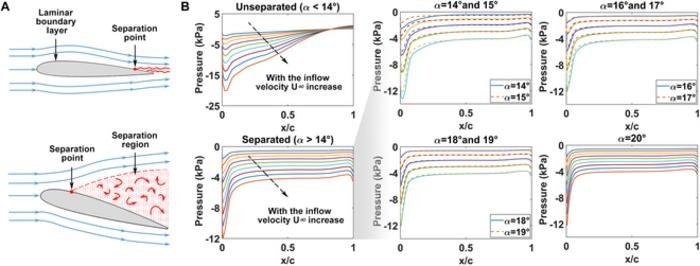Engineers have long researched the flow of air across airfoils, such as airplane wings, to identify the angles at which flow separation occurs and prevent aircraft stalling. Xi-Jun Yuan and Zi-Qiao Chen, together with other researchers at Shanghai Jiao Tong University, have been studying the use of quantum computing to machine learning as a more precise approach to solving these types of challenges. Their study was published on November 21st, 2023, in the Science Partner Journal Intelligent Computing.
 A. Flow without flow separation and with flow separation. B. Pressure distribution trend without flow separation and with flow separation. Image Credit: Xi-Jun Yuan et al.
A. Flow without flow separation and with flow separation. B. Pressure distribution trend without flow separation and with flow separation. Image Credit: Xi-Jun Yuan et al.
The accuracy of classifying flow separation rose from 81.8% to 90.9% and the accuracy of classifying angle of attack increased from 67.0% to 79.0% when a quantum support vector machine was used instead of a classical support vector machine.
These findings support the idea that, given the size of the datasets involved, applying quantum computing techniques to fluid dynamics problems could be quicker and more accurate than using classical computing techniques. Beyond the design of aircraft, target tracking and underwater navigation are possible uses for quantum support vector machines.
The scientists carried out two classification assignments. First, a small dataset was subjected to a binary classification to determine if flow separation was taking place. Since it is challenging to obtain high-accuracy classification for small datasets, a small dataset was used. Pressure sensors on an airfoil in a wind tunnel operating at various airspeeds and angles of attack provided the data for this challenge.
There are 45 multidimensional points in the dataset: 18 examples with flow separation and 27 cases without. Thirty-four training points and 11 testing points were allocated to this dataset.
The second challenge was more challenging. It assigned the angle of attack of the airfoil after flow separation to one of four categories. To do this, the issue was divided into four one-versus-all classification problems, with a binary in-or-out classifier for each category. Data for this challenge were generated using simulation.
The dataset consists of 63 multidimensional points collected by sampling. This dataset was split into 43 points for training and 20 for testing. The training and testing process was done ten times using various combinations of training and test data, yielding an average accuracy of ten tests.
The researchers used a quantum-annealing-based supervised machine learning technique known as a support vector machine. The quantum annealer they employed was the D-Wave Advantage 4.1 system, which is a physical quantum computing device.
Support vector machine systems implemented by quantum annealing have proven to perform better than conventional versions, which are resilient and physically simple but difficult to scale up due to high storage and computation costs.
An optimization technique called quantum annealing uses quantum fluctuations to find a global minimum among a range of solutions. Compared to other optimization techniques that are more prone to becoming trapped at a local minimum, this procedure can obtain more accurate results since it generates numerous acceptable candidates for the global minimum.
Journal Reference:
Yuan, X.-J., et. al. (2023) Quantum Support Vector Machines for Aerodynamic Classification. Intelligent Computing. doi:10.34133/icomputing.0057